Edinburgh Corporation Tramways
History
Edinburgh's first street tramway, which was standard-gauge and horse drawn, opened on the 6th November 1871, the first section running between Haymarket (in Edinburgh) and Bernard Street (in Leith). The tramway was owned and operated by the Edinburgh Street Tramways Company, which obtained powers to build a series of lines on the 29th June 1871, the initial network of lines being completed on the 14th May 1875. Powers for extensions to the system were obtained in 1874, 1875, 1881 and 1882, the last new lines opening on the 1st November 1883.
The company's profitable existence was only clouded by the threat of municipalisation, Edinburgh Corporation having the right to purchase the original tranche of lines — under the Tramways Act of 1870 — 21 years from their authorisation, i.e., in November 1892. During August 1890, the council made it known that it intended to purchase these lines, formally taking the decision to do so on the 1st December 1891. The ESTCo was probably not unduly concerned by this course of action, as local authorities were not allowed (at the time) to operate tramways, so it could reasonably have expected to enter into a lease agreement with the corporation. Planning ahead, the company reached agreement with both Leith Town Council and Portobello Town Council to continue operating in their areas.
On the 12th August 1892, Edinburgh Corporation served notice of its intention to compulsorily purchase the original series of lines within the municipal boundary, and in so doing, caused major irritation to the authorities in Leith and Portobello, which had hoped to agree a common approach to the tramway system. The corporation, however, had a further surprise up its sleeve, both for the neighbouring authorities and the ESTCo, when it announced — on the 11th October 1893 — that the successful bidder for the lease of the system was Messrs Dick Kerr and Company Limited of Kilmarnock, and not the ESTCo.
The corporation (driven by a powerful faction within it) was also developing plans for an extensive cable system in the city, and intended to convert the existing horse tramway lines to this mode of traction, as well as to build extensions to it. Powers to this end, and to enter into a 21-year lease of the system, were obtained on the 29th June 1893 under the Edinburgh Corporation Tramways Act 1893, with further powers following on the 7th August 1896, under the Edinburgh Improvement and Tramways Act 1896.
The corporation took possession of all the lines within the city on the 9th December 1893 (circa 11.75 miles), bar the tracks from Waterloo Place to Jocks Lodge on the company's Portobello line. The deal included 70 horsecars and 600 horses, all of which were immediately sold on to DK&Co, the ESTCo having effectively been reduced to a third of its former size. DKCo worked the system itself for a few months, then handed it over to a newly formed subsidiary in July 1894, the Edinburgh and District Tramways Company. Whilst through services between Edinburgh and Leith were initially maintained, the respective companies could not reach agreement on the precise details, which ended — on the 24th December 1894 — with a Board of Trade arbitration decision to maintain through tramcar services, but with the horses and crews being changed at the municipal boundary at Pilrig. This arrangement benefitted no one, least of all the travelling public, and was colloquially known as the 'Pilrig Muddle'.
The corporation's planned cable system was not the first in Edinburgh, this accolade going to the Edinburgh Northern Tramways Company, which operated 2.61 miles of standard-gauge cable tramway to the north of Princes Street, its first services having started as early as the 29th January 1888. The success of the system no doubt played a critical role in convincing the corporation to adopt this mode of traction, which though expensive to construct, was eminently suitable for the steep gradients within the city. The ENTCo's two lines lay wholly within Edinburgh, and were presumably not purchased at the same time as the ESTCo's lines, as they had been constructed under an Act of 1884, so could not be compulsorily purchased until 1905 (i.e., 21 years after authorisation). In 1896, however, the corporation reached agreement with the ENTCo to purchase the tramway. Rather than wait for the corporation to acquire the necessary powers, the ENTCo agreed to hand over operation to the E&DTCo, which it did on the 1st January 1897. DK&Co were presumably instrumental in this agreement, as they not only controlled the E&DTCo, but very possibly the ENTCo too (at the very least they were a significant shareholder). The corporation duly obtained powers to acquire the tramway on the 3rd June 1897, under the Edinburgh Corporation Act 1897, the undertaking passing into corporation ownership on the 1st July 1897, with the cable trams being immediately sold to the lessee, the E&DTCo. The 1897 Act also contained powers for additional extensions and modifications to the planned cable-tramway system.
Meanwhile, on the 31st January 1896, the corporation also acquired the Waterloo Place to Jocks Lodge section of the ESTCo's Portobello line, the rest of the line out to Portobello following on the 30th June 1898 at a mutually agreed price. The following day, the E&DTCo commenced a new 21-year lease of the system, the old unratified, and therefore legally questionable lease having put paid to yet another attempt to reunify the tramway systems in Edinburgh and Leith, which would have involved Leith Corporation purchasing the ESTCo's lines within its municipal boundary, and leasing them to the E&DTCo.
Trials of the new cable trams began on the 1st June 1899, with the first officially sanctioned services starting on the 26th October 1899 between Pilrig and Braid Hills Road, thus putting paid to through-running between Edinburgh and Leith. The remaining lines of the new cable system opened in stages during 1900, with the last line of those first authorised — to Portobello and Joppa —opening on the 1st May 1902.
On the 23rd October 1904, Leith Corporation purchased the remaining lines and assets of the ESTCo, a move which inevitably perpetuated the 'Pilrig Muddle', as Leith Town Council had, two weeks beforehand, taken the decision to use overhead electric traction rather then Edinburgh's favoured cable haulage.
On the 4th August 1906, powers for conversion of the corporation's Craiglockhart line, as well as a new line between Broughton Street and Canonmills, were obtained under the Edinburgh Corporation Act 1906. However, doubts now began to surface within the corporation as to the wisdom of building further cable lines; not only were they extremely expensive to construct, but they were now seen as 'old technology' in comparison to electric traction. The council was, however, opposed to overhead electric traction on the grounds of civic disfigurement, so investigated the various surface-contact options then in use around Britain. In the end, however, it was felt that a mix of surface contact and cable track would simply be too challenging to install, and on top of that, the lessee (the E&DTCo) made it clear that it was not at all interested in operating a mix of the two. In February 1907, the council therefore decided that the Craiglockhart, and the Broughton Street to Canonmills lines would be converted to cable traction; these were opened on the 7th April 1908, and the 20th October 1908, respectively.
Barely two years later, however, the pendulum had swung fully over to overhead electric traction, the council deciding to build a new line out from Ardmillan Terrace to Slateford using this mode of traction. The new line was opened on the 8th June 1910, but was operated by the E&DTCo under a separate lease, which was timed to end with the main 21-year lease on the 30th June 1919.
On the 31st October 1912, the council voted to take over operation of the tramway system following the expiry of the E&DTCo's lease; a subsequent report by the borough engineer recommended a mix of overhead electric tramway and motorbus services, powers for the latter, including operation outside the municipal boundary, being obtained on the 15th August 1913 under the Edinburgh Corporation Act 1913. Although the first corporation motorbus services were introduced on the 3rd August 1914 — operated at cost by the E&DTCo — they lasted barely three months before withdrawal, most of the vehicles having been requisitioned by the War Department.
The system dramatically deteriorated during the Great War, suffering from a loss of skilled men to the armed services, government restrictions on spares and new materials, and heavy passenger loadings, all of which impacted an infrastructure that was approaching the end of its useful working life. A measure of the neglected state of the tramway comes from a independent corporation-commissioned report into the tramcar fleet, which in May in 1916 found that only two trams out of a fleet of circa 200 vehicles, were described as 'in order'. An effort was made to improve the situation, which was partially successful, the tramway limping on through the war, towards its impending replacement.
Meanwhile, on the 17th May 1916, the corporation obtained powers for extensions to the system (under the Edinburgh Corporation Order Confirmation Act 1916), though progress with these would have, per force, to await the conclusion of the conflict.
The corporation took over operation of the run-down tramway on the 1st July 1919, including all the tramcars and staff. Around four months later, on the 20th November 1919, the corporation obtained powers — under the Edinburgh Corporation Order Confirmation Act 1919 — to convert the system to overhead electric traction section by section. Twelve motorbuses were also purchased, which were soon joined by more; these vehicles were not only deployed to minimise disruption to the travelling public during reconstruction of the tramway system, but were also used to open up new routes.
The corporation had also successfully concluded negotiations with several neighbouring authorities for a significant expansion of the city, powers for this being granted on the 4th August 1920 — under the Edinburgh Boundaries Extension and Tramways Act 1920 — an act which also included extensions to the tramway system. The civic expansion included neighbouring Leith, Leith Corporation Tramways being merged into Edinburgh Corporation Tramways on the 2nd November 1920.
Meanwhile, the first reconstruction of the old tramway system had begun (on the 18th October 1920), though it was not in fact a cable tramway, but the one overhead electric tramway line — Ardmillan Terrace to Slateford — that had been operated by the E&DTCo. The first cable-tramway closure for conversion — the Comely Bank line of the former ENTCo — took place on the 2nd December 1920. Other closures soon followed, work continuing apace to not only convert the old cable lines, including rebuilding of the cable tramcars, but also the provision of the necessary electricity generation and distribution infrastructure.
The first section of newly converted line to open was from Pilrig to Nether Liberton on the 20th June 1922, which allowed several services between Edinburgh and Leith to commence, consigning the 'Pilrig Muddle' to history. Other lines and extensions followed throughout 1922 and 1923, the last cable tram of all running on the Portobello line on the 23rd June 1923. Through services over the Musselburgh and District Electric Light and Traction Company's line from Portobello to Port Seton commenced the next day, the corporation running through to Musselburgh Town Hall and to Port Seton, the latter operated as a joint corporation-company service.
Conversion of the last of the old cable-operated lines was completed on the 8th June 1924 with the commencement of services over the former ENTCo Hannover line. This was quickly followed, on the 1st August 1924, by powers for further extensions, which were granted under the Edinburgh Corporation (Tramways, etc.) Confirmation Act 1924.
A number of extensions were opened between 1924 and 1926, with provisional powers for yet more extensions being sought in 1927. The department responsible for the tramways and motorbuses was renamed in early 1928 — to Edinburgh Corporation Transport Department — reflecting the significant expansion of motorbus services, the latter now serving several of the new housing schemes.
Following severe motorbus competition by White Line motorbuses, the corporation's partner in the tramway services to Port Seton, the M&DEL&TCo, decided to withdraw its tramway services and replace them with motorbuses. The corporation ceased to run beyond Levenhall on the 26th November 1927, and following the company's withdrawal of regular tram services on the 25th February 1928, it was effectively left as the sole provider of tramway services over the company's tracks. A few days later, on the 1st March 1928, the company reached agreement with the corporation for the latter to operate all tramcar services through to Levenhall, the company maintaining the track and providing the current. In 1930, the company offered the remaining operational section of the tramway, as well as its Port Seton motorbus services, to the corporation; the latter had, however, to decline, as it did not have powers to operate motorbuses outside the city, and any attempt to acquire them would have met with significant objections from the main bus operator, Scottish Motor Traction. The corporation was nevertheless still keen to bring the line under its ownership, and on the 7th May 1931, it reached agreement with the company to buy it, taking over responsibility for the line the next day, until powers for the acquisition were obtained. The tramway passed into corporation ownership on the 25th April 1932, under the Edinburgh Corporation Order Confirmation Act 1932, following which work was put in hand to reconstruct the life-expired track.
The corporation opened a number of extensions between 1928 and 1934, and obtained powers for yet more in February 1935 under a Provisional Order. The last extension to open — on the 14th February 1936 — was from North Gyle Farm to Maybury Road, though this was not actually the last line to be built, this honour going to an extension along Ferry Road to Crewe Toll, the completion (and opening) of which was stopped by the outbreak of war.
Unlike the Great War, the conflict did not significantly impact the tramway, the main effect being on the operation of motorbuses as a result of petrol rationing. The corporation had fortunately built up a sizeable stock of track and spares, so was able to maintain the system and the tramcar fleet in good condition throughout the war.
In 1947, the tramway achieved its peak passenger numbers, almost 193 million being carried, compared with 83 million on the motorbuses.
In June 1950, the Corporation Transport Manager recommended that the tramway (and the tram fleet) be reduced by 25%, with the services being taken over by motorbuses; this was in spite of the fact that the trams were profitable, and that they still carried around twice as many passengers as the buses. There was clearly little appetite within either the senior departmental management or the council to invest in the tramway, an attitude that was common across the country at the time, and on the 2nd November 1950, the council formally endorsed the manager's recommendation. The first line to go was Comely Bank, its tram services replaced by motorbus services on the 1st June 1952. Just over three months later on the 25th September 1952, the council ceased a huge public outcry when it endorsed the complete scrapping of the tramway system; there was much criticism of, and challenge to, the council, with its members having to publicly defend the decision, some even massaging the financial figures to make out that the trams were operating at a loss, when they were not.
All this had absolutely no effect on the council's decision, the next line closing on the 25th March 1954, with the rest of the system gradually following, until the trams final day arrived on the 16th November 1956.
At its maximum, Edinburgh Corporation operated 47.25 miles of standard-gauge, overhead electric tramway. From Princes Street, lines ran: southwards to Marchmont and Braids; southwestwards to Colinton, Slateford and Gorgie; westwards to Corstorphine; northwestwards to Comely Bank; northwards to Goldenacre, Granton and Newhaven; northeastwards to Leith and Seafield; eastwards to Portobello and Levenhall; and southeastwards to Liberton. In addition, there was a large number of connecting lines, enabling a comprehensive set of services to be delivered.
Uniforms
After taking over the operation of its system from the lessee, the corporation embarked upon the not insignificant task of rebranding the enterprise, including of course, staff uniforms and insignia. For drivers, the corporation merely continued the uniform policy of its predecessor, only changing those items that were company specific, namely, the buttons and the cap badges. Drivers therefore continued to wear double-breasted, lancer-style tunics with five pairs of nickel buttons (bearing the corporation arms — see link) and stand-up collars; the latter carried an employee number in individual nickel numerals on both sides. The tensioned-crown peaked caps now bore a script-lettering grade badge — 'Driver' — above which a new nickel cap badge was worn; this comprised the arms of Edinburgh above the city motto (in a ribbon), all surmounted by a curved banner inlaid with blue enamel, containing the word: 'TRAMWAYS'. In contrast to the approach outlined above, conductors' uniforms were changed to a completely different style from that of the E&DTCo, namely: single-breasted jackets with five buttons, two breast pockets (with button closures) and stand-up collars; the latter again bore employee numbers on both sides. For reasons now lost in the mists of time, the corporation chose to issue conductors with rather old-fashioned drooping-peak caps, though these appear to have been relatively quickly superseded by the same style of tensioned-crown peaked cap worn by drivers; the caps bore an off-the-shelf, script-lettering grade badge — 'Conductor' — above which, the new cap badge was worn.
The uniforms were completely redesigned in the late 1920s, with jackets, trousers and caps all now piped in red, which made for a very smart appearance against the blue of the main body. The corporation, however, continued its policy of issuing different styles of jacket to drivers and to conductors; the former were issued with double-breasted jackets with four pairs of buttons, two waist pockets and lapels, whilst the latter were issued with single-breasted jackets with four buttons, two breast pockets (with button closures) and lapels. The collars bore an employee number on the bearer's left-hand side and individual system initials — 'E C T' — on the right-hand side, sometimes worn in line with the collar, sometimes transverse to it. The buttons and insignia were in nickel, though a switch was no doubt made to chrome in the 1930s or 1940s. Photographs show that the jackets sometimes bore epaulettes (with button closures, but devoid of insignia), and sometimes not, suggesting that the styles changed subtly over the decades. The caps were also piped, and carried the same cap badges as previously.
Given that the name of the undertaking was changed in early 1928, it is almost certain that uniforms after this date would have borne 'Edinburgh Corporation Transport' insignia.
Tramcar crews were also issued with double-breasted greatcoats — these again appeared to have differed slightly between drivers and conductors, the former having five pairs of buttons (initially in a lancer-style arrangement) and high, fold-over collars, the latter having four parallel pairs of buttons and lapels. Both styles bore epaulettes (with button closures), again devoid of insignia. At the same time that the uniforms were changed to the new smarter piped style (late 1920s), the style of the greatcoats were also changed; these were now double-breasted with four pairs of buttons, lapels and epaulettes. The latter were as usual devoid of insignia, whereas the collars now bore 'E C T' initials on the bearer's right-hand side and an employee number (probably) on the left-hand side.
Edinburgh also made use of auxiliary conductors — during the Second World War — initially Transport Department office staff pressed into service, but later on members of the public who obtained free travel in return for helping the conductor with his non-revenue duties. Armbands were worn to show that these individuals were indeed acting in an official capacity, and both white linen/canvas and dark-blue serge examples (matching the uniforms) have survived (see below); the former were the initial, almost makeshift issues, probably used by the office staff, the latter being issued once the department was convinced that the scheme was working.
Edinburgh also employed parcels boys and points boys. Both grades wore single-breasted jackets identical to those worn by conductors, initially with kepi-style caps and later on (probably from the mid 1930s), tensioned-crown peaked caps. The caps bore nickel, script-lettering grade badges — 'Points Boy' or 'Parcels' — the former being a two-piece rather than a one-piece badge. In the case of points boys, the standard municipal cap badge was worn above the script-lettering grade badge; parcels boys, however, seem to have made do without until around the 1930s, and possibly even later. Points boys, who stood outside in all weathers, were issued with heavy-duty double-breasted greatcoats, whilst parcels boys tended to wear a lighter-weight variety similar to tramcar crews. A photograph of a pointsman (not a boy) — taken in 1922 — shows the individual wearing a single-breasted jacket with three hip/waist level pockets (with flaps), four buttons and lapels; other than the buttons, the jacket appears to have been devoid of insignia. The tensioned-crown peaked caps carried a script-lettering grade badge — 'Pointsman' — along with the standard cap badge.
Photographs of regulators indicate that they may initially have worn single-breasted jackets edged in a finer material than the main jacket, with hidden buttons (or more likely a hook and eye affair) and stand-up collars; the latter appear to have borne the grade — 'Regulator' in embroidered script lettering. Caps were initially a drooping-peak style with a pom pom and piping, and were almost identical to those worn by senior staff in E&DTCo days (see link); they carried the standard cap badge, but without a grade badge. The style of the jackets was later changed — probably in the 1930s — to a single-breasted design with four buttons and lapels; the bearer's left-hand collar continued to carry the grade in embroidered lettering (possibly script lettering), but the right-hand collar now bore system initials ('E C T'), possibly in embroidered block letters. The jackets were probably changed one final time to a double-breasted design just before or shortly after, the Second World War.
Inspectors probably wore the same jackets as regulators initially, though there is some evidence to suggest that a switch was quickly made to double-breasted jackets with three pairs of buttons, and lapels; curiously, the latter appear to have been left plain, i.e., without a grade badge. Caps were initially in a drooping-peak style with a pom pom on top, and like regulators, simply carried the standard cap badge; these caps were superseded by tensioned-crown peaked caps some time in the mid-to-late 1920s. Inspectors were also issued with double-breasted overcoats with four pairs of buttons, and lapels; the collars were edged in a lighter coloured material than the main garment, and also bore lettering, more than likely the grade — 'Inspector' — and probably embroidered.
The corporation inherited a significant number of conductresses from the E&DTCo, seemingly dispensing with their services with alacrity, so they simply continued to wear their company attire, even down to their cap badges. The corporation also employed a significant number of ladies during the Second World War, appointing its first conductresses in May 1941 (on the motorbuses) and having over 600 just one year later! The ladies were issued with tailored, piped, single-breasted jackets with four buttons, two breast pockets (with button closures) and lapels; the collars bore 'E C T' initials on both sides. A matching skirt was also provided, along with a baggy peaked cap that bore the usual municipal cap badge, though seemingly without a script-lettering grade badge.
Further reading
For a detailed history of Edinburgh Corporation Tramways, see: 'Edinburgh's Transport - Volume 2, The Corporation Years' by D L G Hunter; Adam Gordon (1999).
Images
Motormen and conductors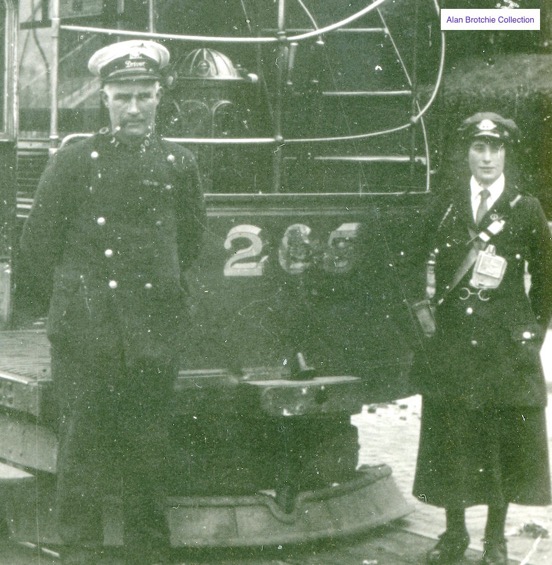
An interesting photo of a rather battered-looking cable tram (No 205), along with a cable-tram driver (in corporation uniform) and a conductress (in Edinburgh & District Tramways Co uniform) — photo undated, but probably taken in late 1919 or early 1920.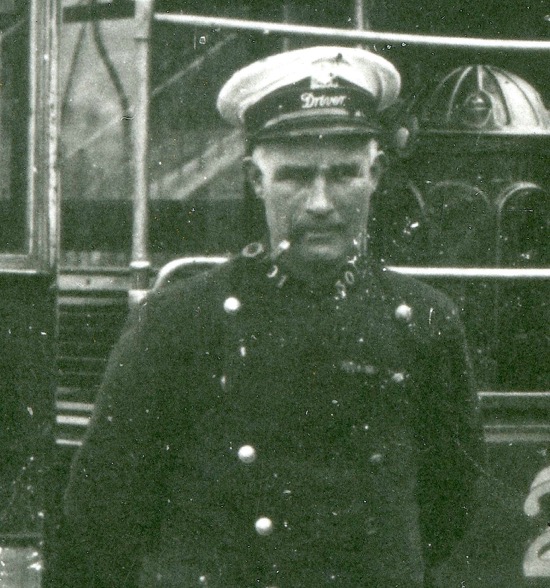
An enlargement of the above photograph showing details of the driver's (No 301) uniform.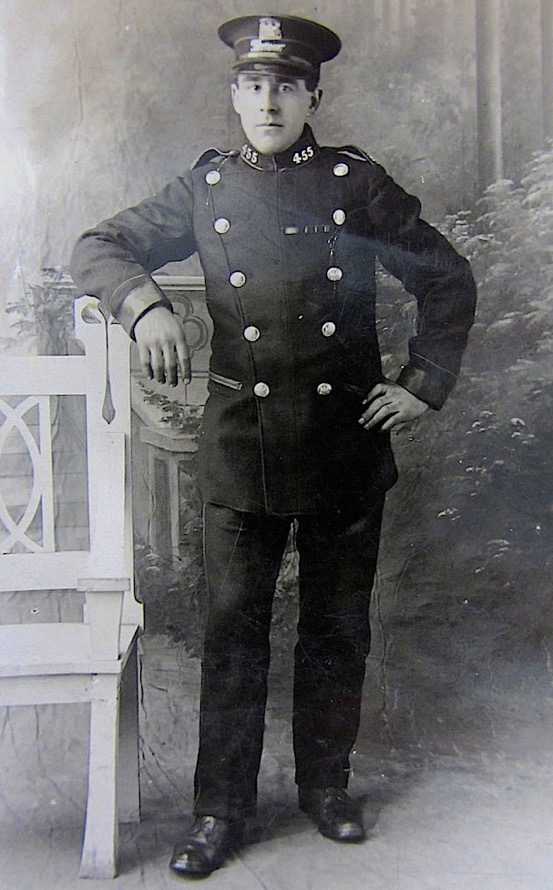
A studio portrait of an ECT driver (No 455) — photo undated, but probably taken around the time of municipalisation, i.e., 1919 or 1920.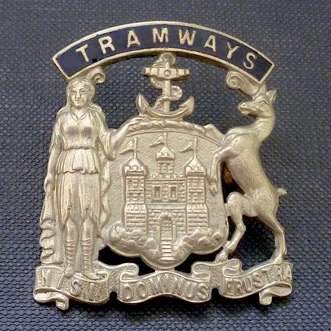
Edinburgh Corporation Tramways cap badge — nickel and blue enamel. Author's Collection.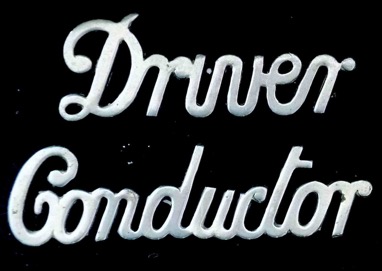
Script-lettering grade badges of the type used by Edinburgh — nickel. Author's Collection.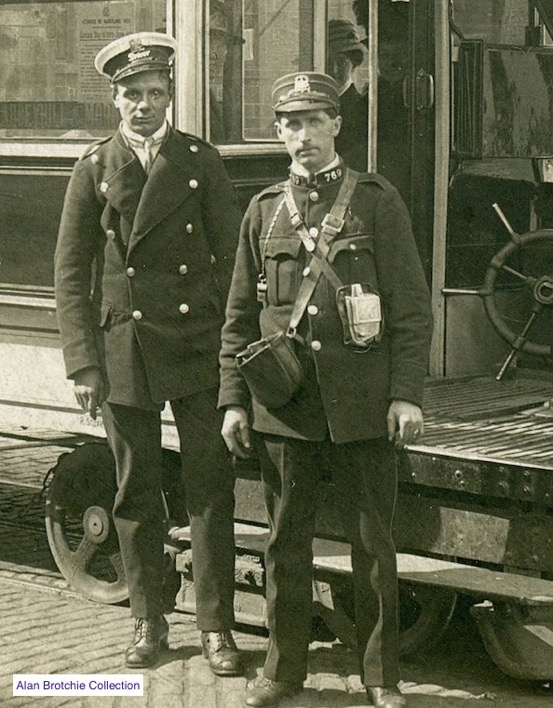
Looking for all the world like an Edwardian photograph — probably due to the rather old-fashioned drooping-peak cap worn by the conductor — but one which was actually taken after the corporation take-over and very probably in early summer 1921, given that a poster inside the vehicle appears to announce Census Day, which was the 19th June that year. The driver and the conductor (No 769) are pictured at the Abbeyhill Terminus (Norton Place) in front of Cable Tram No 166, with a Number 5 service to Morningside Station. It is unclear why the corporation adopted the curious practice of issuing drivers with tensioned-crown peaked caps but conductors with rather anachronistic drooping-peak caps; one wonders what the conductors thought of this, given that they had worn more modern tensioned-crown peaked caps in the latter years of the company (see link). With thanks to Alan Brotchie for the background information.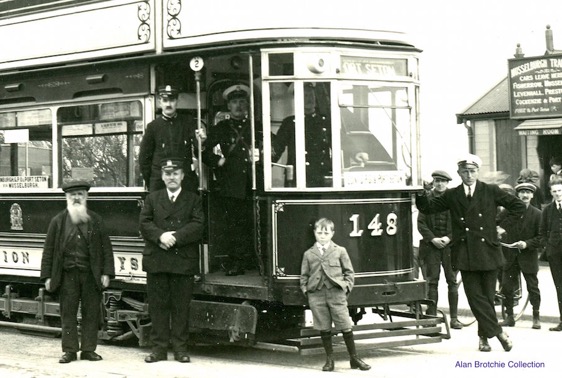
Two senior staff (regulators or inspectors), a conductor and a driver pose with Tramcar No 148 on one of the first through services to Port Seton, on the Musselburgh and District Tramways system — 23rd June 1923. Photo by E O Catford.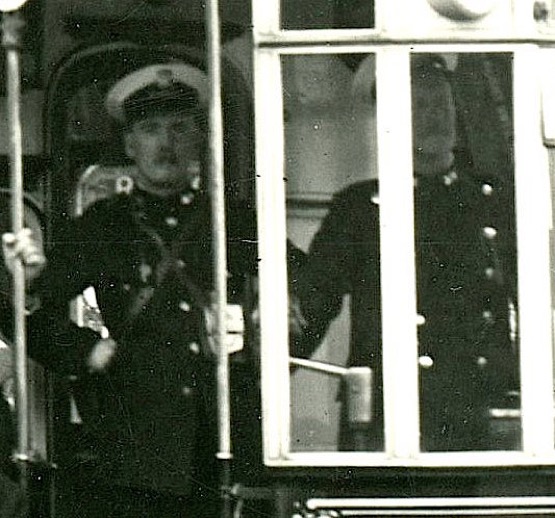
An enlargement of the above photograph, showing the conductor in single-breasted jacket, but wearing a tensioned-crown peaked cap rather than the old-fashioned drooping-peak caps with which they were initially issued.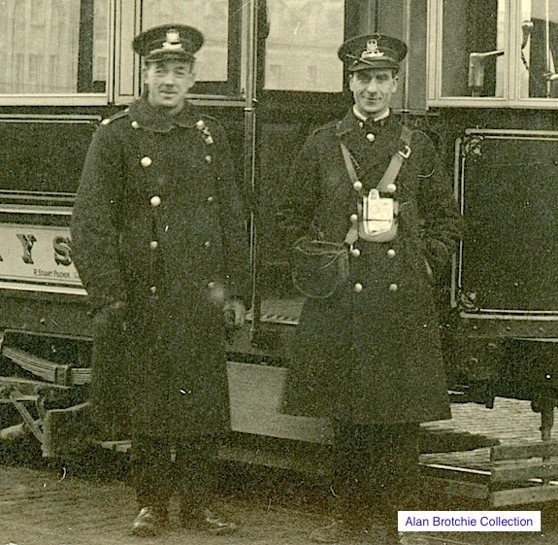
A driver and a conductor with Tramcar No 272 on a service to Piershill — photo undated, but probably taken in the mid 1920s. Note the differing styles of greatcoat.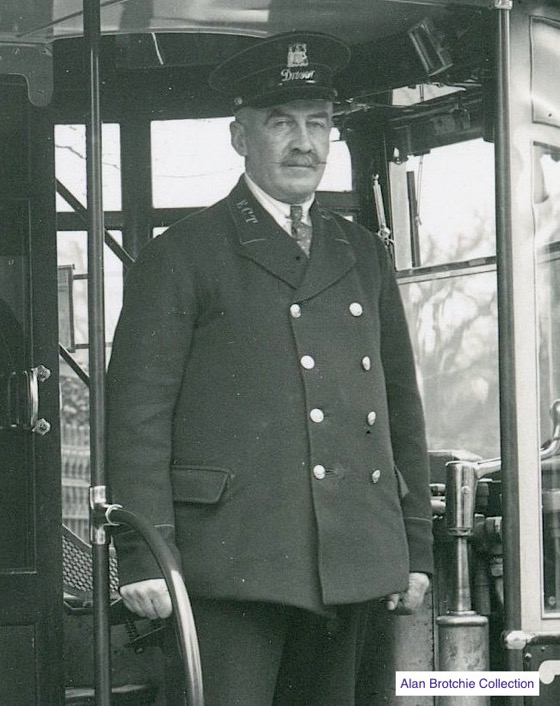
An ECT electric-tram driver in a new, much smarter style of piped, double-breasted jacket on the platform of newly built Tramcar No 180 — 1932. Photo by E O Catford.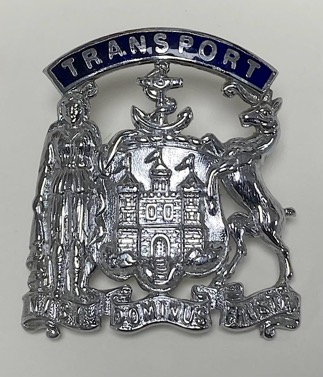
Edinburgh Corporation Transport cap badge — chrome and blue enamel. New uniform issues from the early 1930s onwards probably bore this pattern of cap badge, initially in nickel, but later in chrome. With thanks to the National Tramway Museum.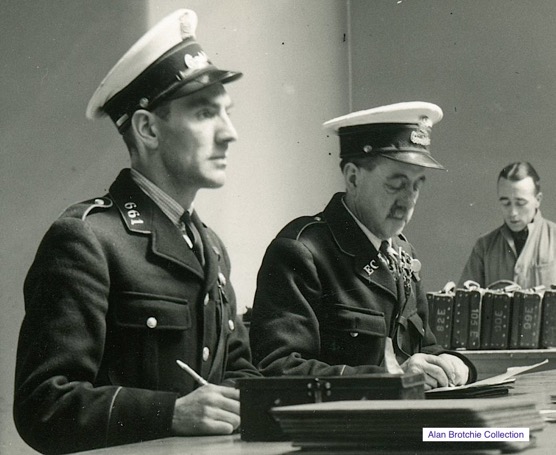
An excellent study of two conductors cashing in their takings at Tollcross Depot circa 1938. The single-breasted jackets bear badgeless epaulettes. The collar on the subject nearest the camera bears an employee number (661), whereas that of his colleague bears the more usual 'E C T' initials (here mounted transverse to the collar on the lapel itself). Photo by E O Catford.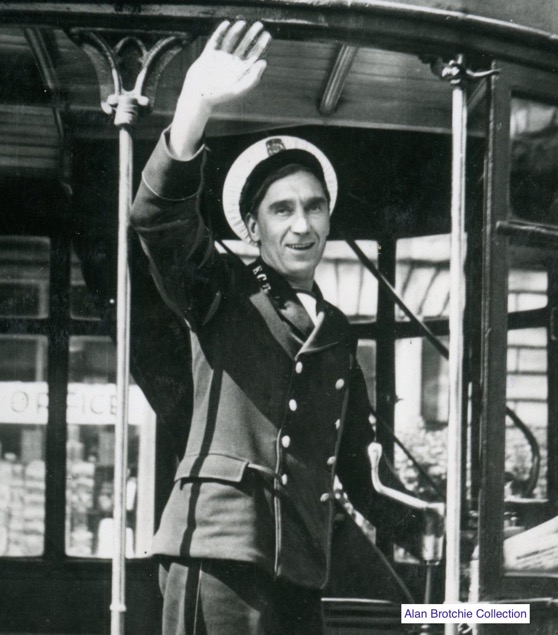
Edinburgh Corporation Tramways motorman — July 1949. His collar initials are mounted in line with the collar rather than at right-angles to it.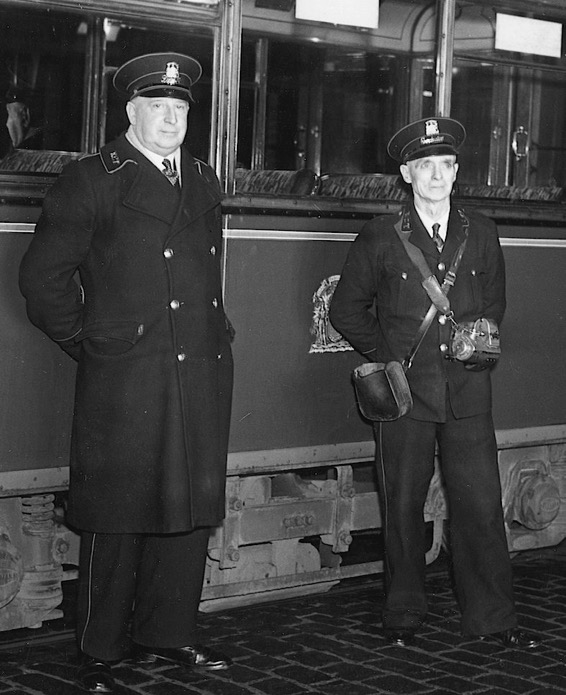
Motorman James Kay and Conductor Andrew Birrell pose for the camera with Edinburgh's last tram, No 272, on the evening of 16th November 1956. The smartness of the piped uniforms, even at this juncture, is testament to civic pride. Author's Collection — with thanks to Alan Brotchie for the background information.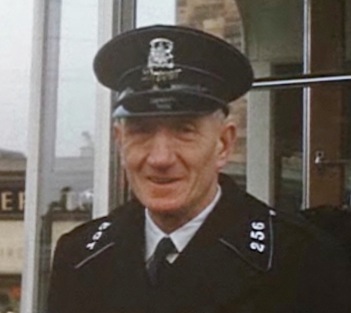
Edinburgh motorman (No 256) — photo taken during the last week of tram services, November 1956. The system initials (right-hand collar) and employee number (left-hand collar) are easily made out. With thanks to Stephen Howarth.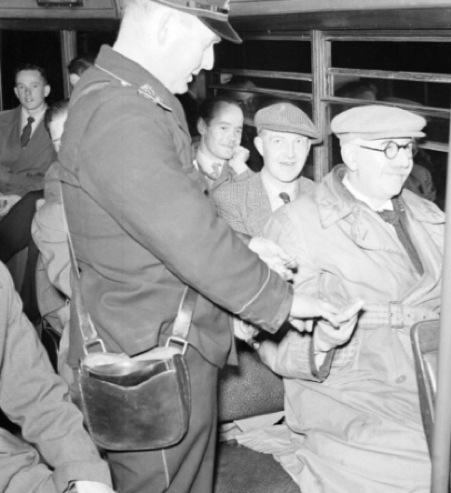
An unusual shot of an ECT conductor, taken on the last evening of operation, 16th November 1956. With thanks to Stephen Howarth.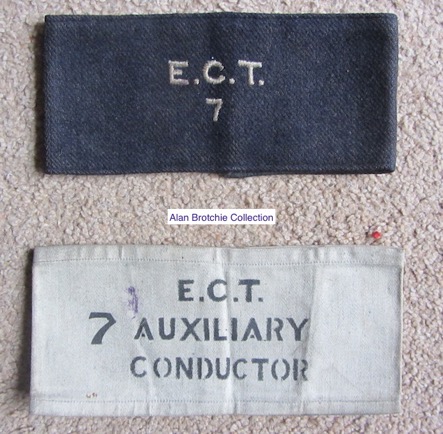
Second World War armbands for Auxiliary Conductor No 7, dark-blue serge and printed white linen; the latter was presumably the earlier of the two, the higher quality serge example replacing it.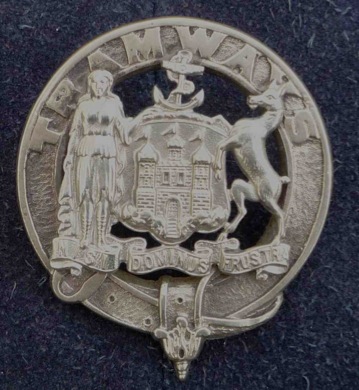
Not strictly speaking a uniform item, but a Glengarry cap badge worn by members of the Edinburgh Tramways Pipe Band — brass. With thanks to David Fraser for this information. Author's Collection.
Parcels boys and points boys/men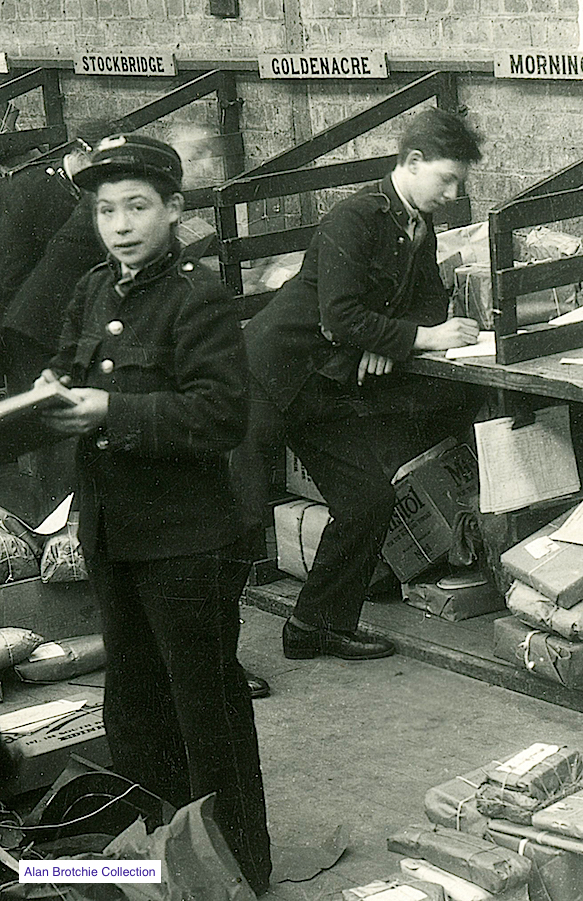
Two youthful-looking denizens of the Parcels Department — photo undated, but probably taken in the 1920s. The kepi-style cap bears a script-lettering grade badge — 'Parcels' rather than 'Parcels Boy' — and without the standard 'Tramways Dept' cap badge.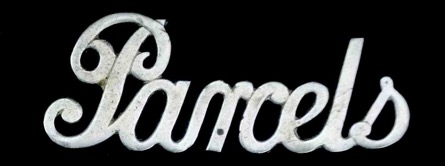
Script-lettering 'Parcels' grade badge — nickel — of the type worn by Edinburgh staff. Author's Collection.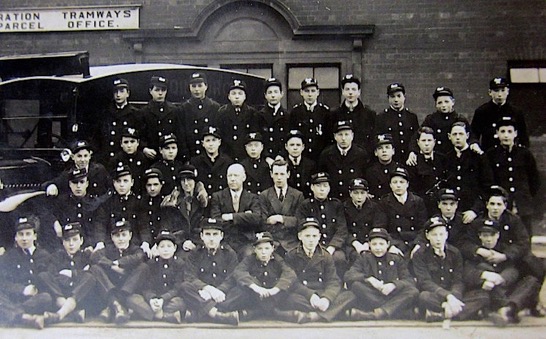
A staff photograph taken outside the ECT Parcels Office — photo undated, but probably taken in the 1930s. Almost all those present are young boys, all in kepi-style caps carrying the standard script-lettering 'Parcels' cap badge.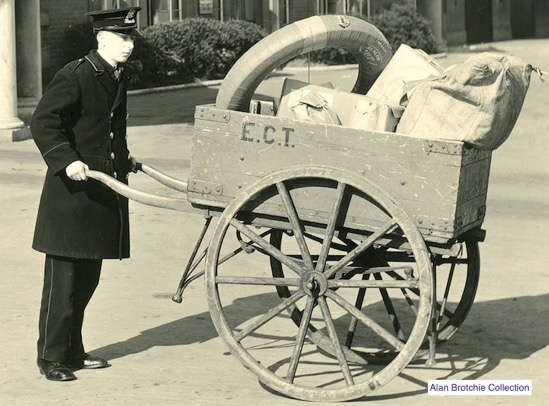
Edinburgh Corporation Tramways parcels boy — photo undated, but probably taken in the 1940s or 1950s. Despite the manual nature of the work, staff were evidently expected to be smartly turned out. Photo by E O Catford.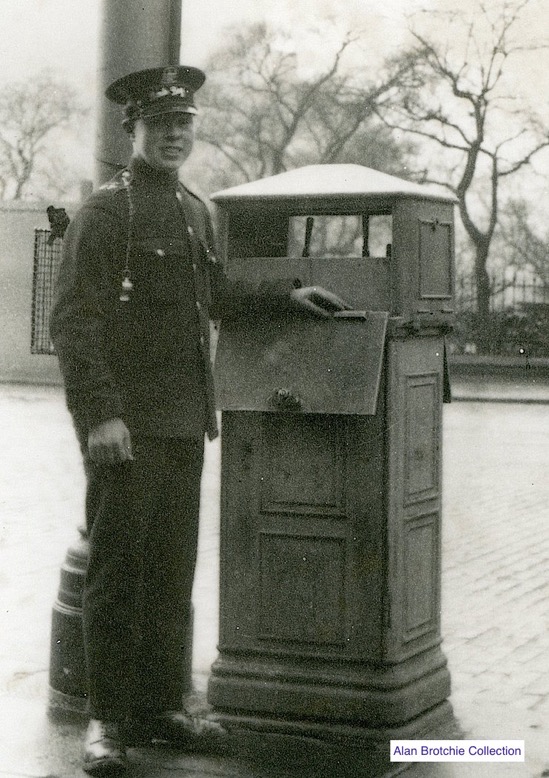
An ECT points boy poses for the camera with his control box — photo undated, but probably taken in the 1920s or 1930s. He is wearing the standard cap badge, along with a two-part 'Points Boy' grade badge. Photo by E O Catford.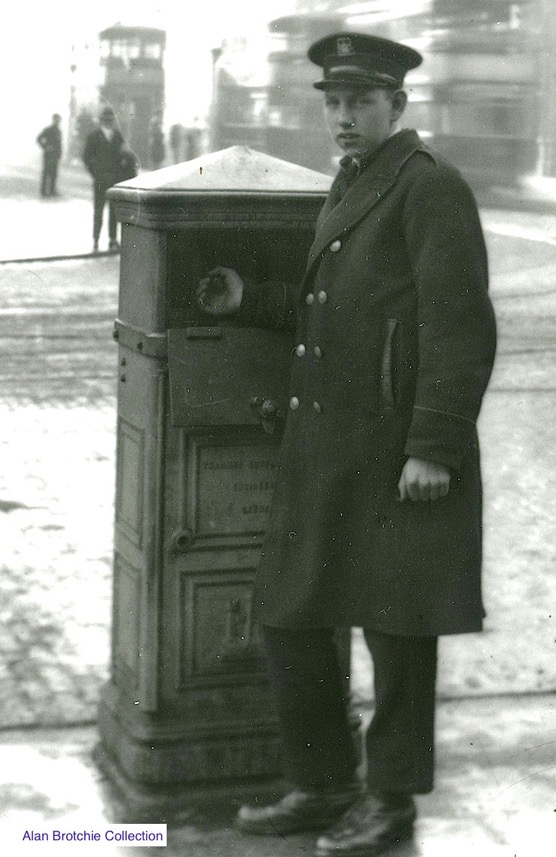
Another points boy at his control box, but this time without grade badge, and wearing an overcoat — photo undated, but probably 1920s or 1930s. Photo by E O Catford.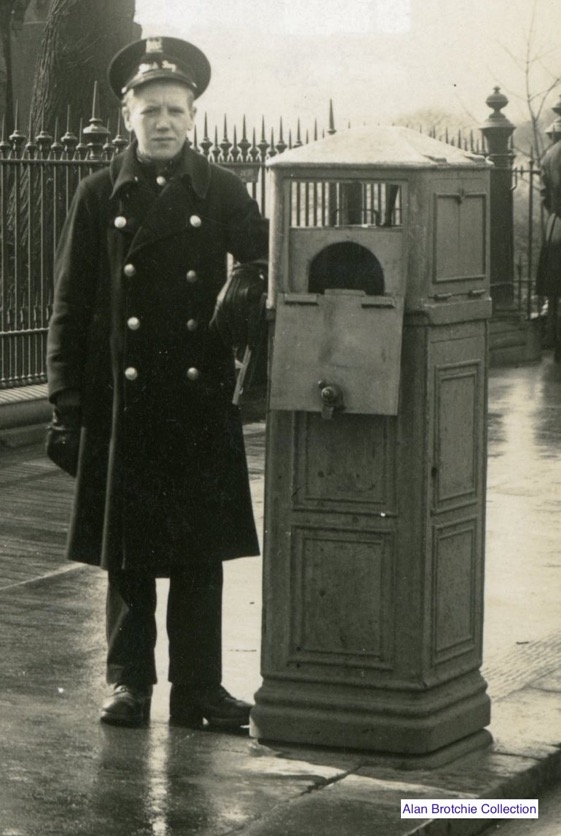
Another fine study of a rather disgruntled points boy at the foot of Frederick Street — photo undated, but again, probably 1920s or 1930s. The reason for his disenchantment may have been boredom, as he would only have had to operate his lever when a No 24 service came along, approximately 1 in 30 cars (with thanks to Alan Brotchie for this information). Photo by E O Catford.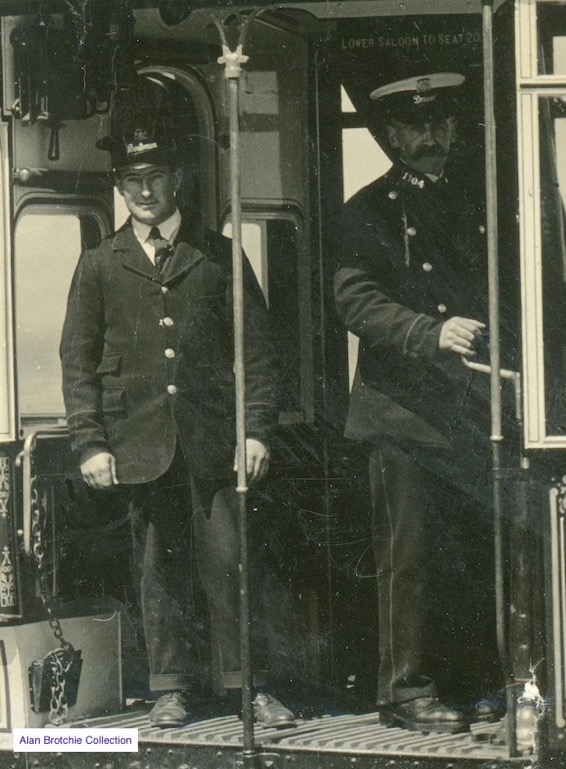
A rare shot of an ECT pointsman aboard newly electrified No 154 (a former cable tram) — photo taken in 1922. 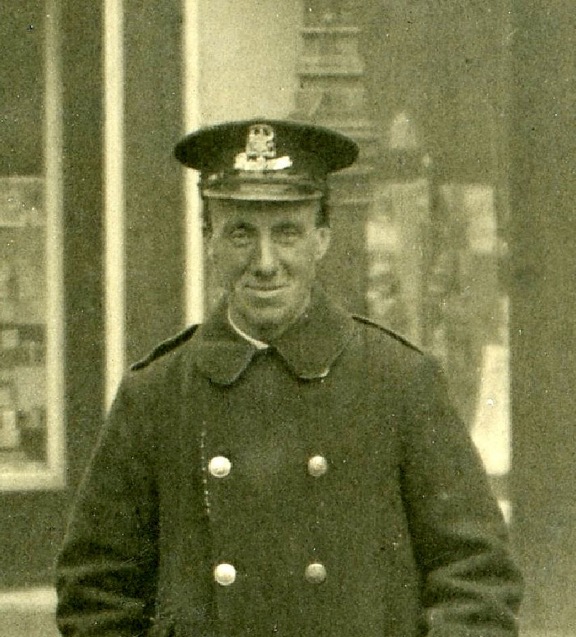
A grainy but rare photograph of a pointsman, taken in the early 1920s. His greatcoat appears to be totally devoid of insignia.
Senior staff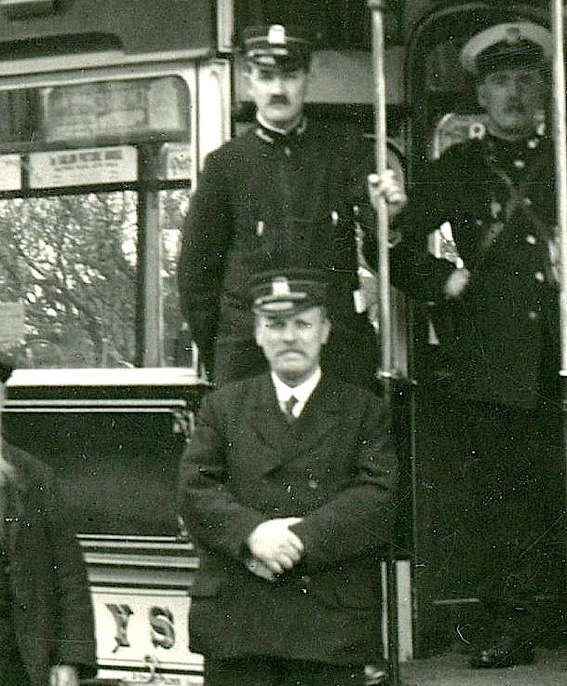
An enlargement of the Port Seton photograph above (taken in 1923) showing the two senior staff; the man behind is possibly a regulator, whilst the man in the foreground may be an inspector. Both men appear to be wearing piped drooping-peak caps virtually identical to those worn by senior staff working for the E&DTCo, though clearly bearing the new corporation cap badge. The jackets may reflect a difference in the grades, though this is merely speculation.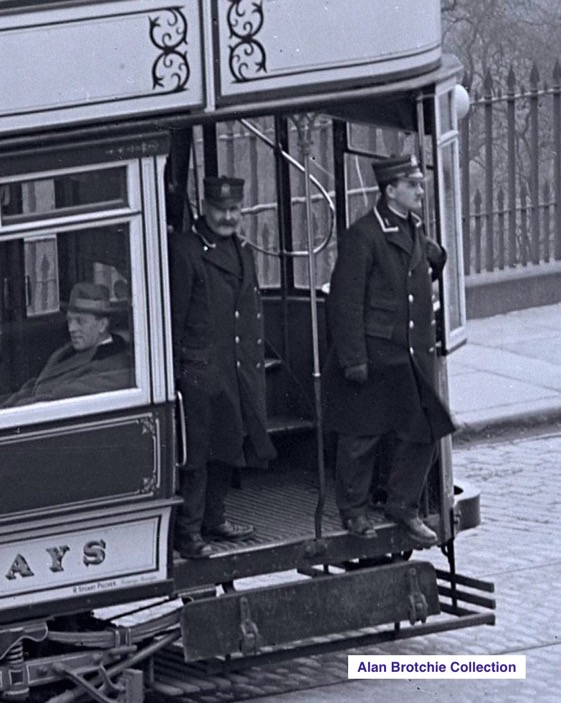
Two senior staff, in all probability inspectors, aboard Tramcar No 209 as it ascends the Mound on what would appear to be a trial run, dating the photograph to June 1924. Both men are wearing drooping-peak caps with pom poms on top, along with the standard 'Tramways' cap badge. The greatcoat collars are edged in material of a contrasting colour to the main garment, and these also bear lettering of some description, most probably the grade, i.e., 'Inspector'. The man seated in the interior is the General Manager, R Stuart Pilcher. 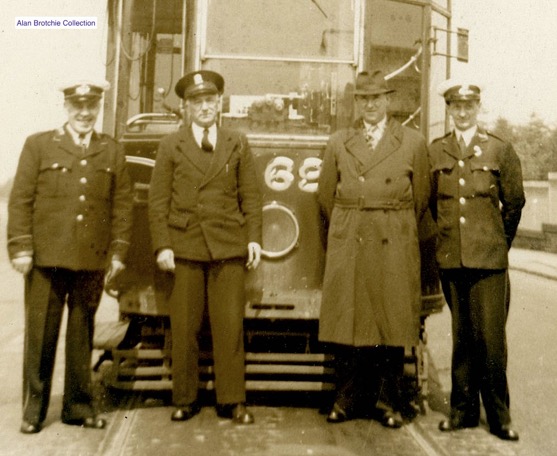
The individual in the middle is probably an inspector — photo undated, but probably taken in the 1950s. Unlike regulators, inspectors appear to have had no badge marking them as such, merely wearing the standard municipal cap badge.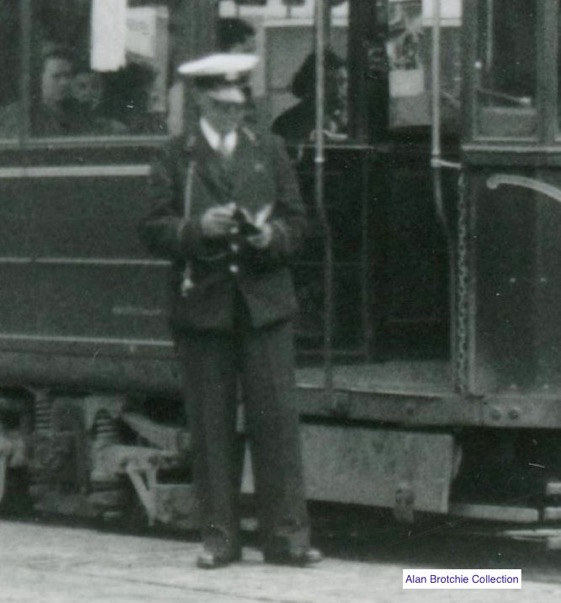
An ECT regulator, book in hand, stands next to Tramcar No 362 at Haymarket with a service bound for Ardmillan Terrace. Photo by Richard Wiseman.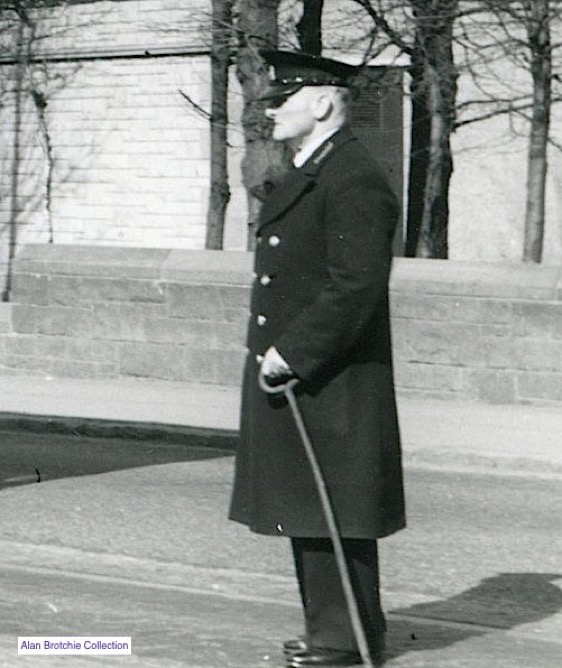
An ECT regulator (?), points iron in hand, supervising Tramcar No 231 (out of shot) at Liberton terminus — photo undated, but probably taken in the 1950s.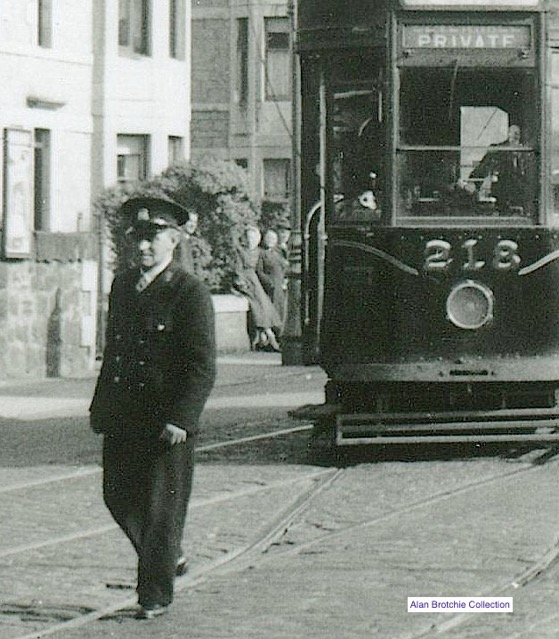
An ECT regulator with Tramcar No 218 at Granton Rd Station — photo undated, but probably taken in the 1950s.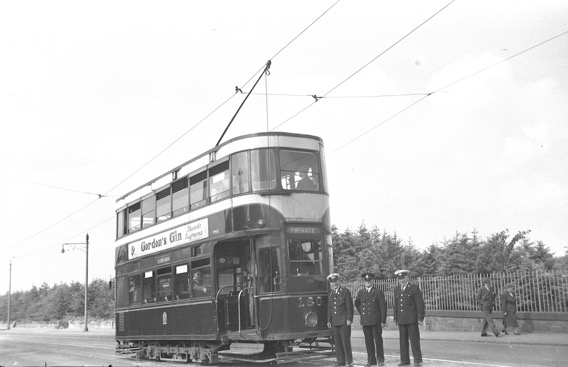
Three ECT staff pose with Tramcar No 180 on a Light Railway & Transport League special on the 31st July 1955. With thanks to the National Tramway Museum. 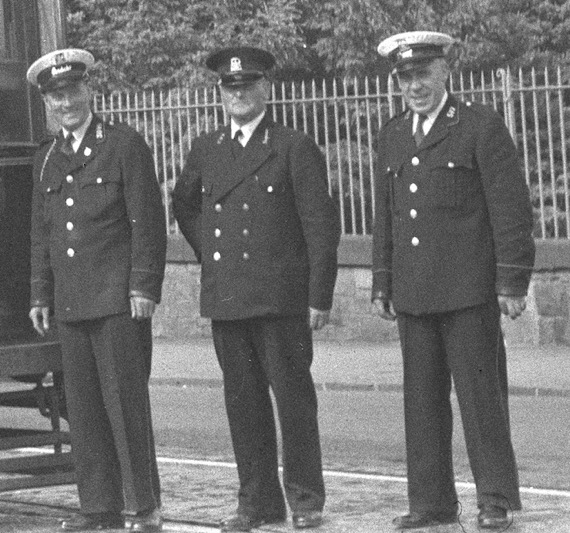
An enlargement of the above photograph showing, from left to right, the conductor, a regulator (?) and the motorman.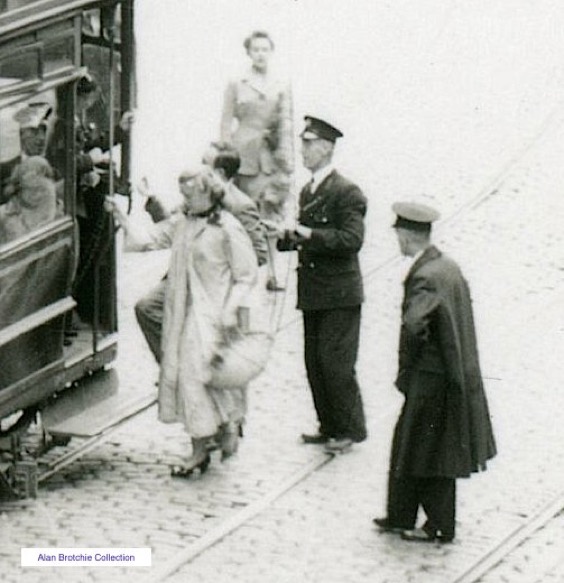
A couple of senior staff assist passengers boarding Tramcar No 148 at the top of Leith Street — photo undated, but probably taken in the 1950s.
Female staff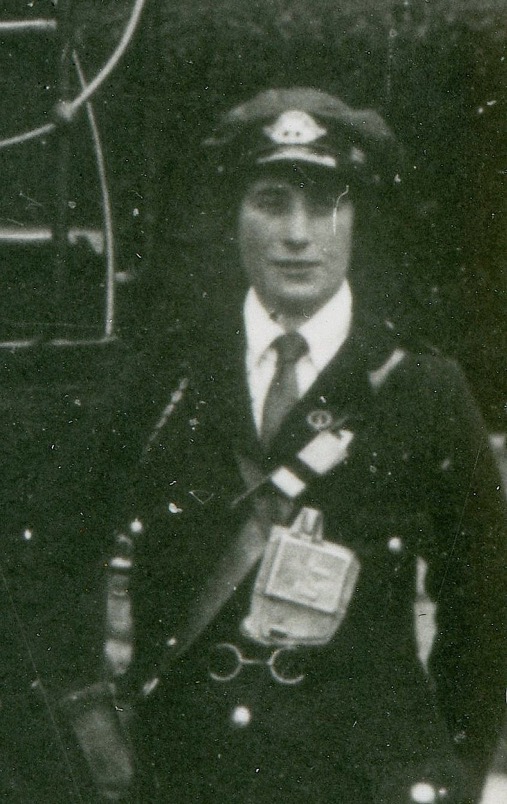
An enlargement of the photograph of Cable Tram No 205 above showing the conductress. Edinburgh Corporation apparently dispensed with their services relatively quickly after their take-over of the E&DTCo, so it would seem that they simply continued to wear their ex-company uniforms, including the prominent cap badges (see link).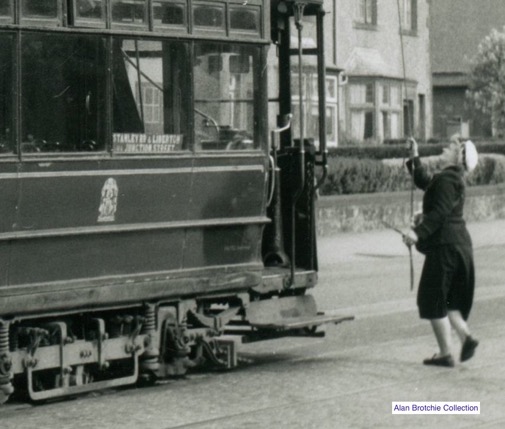
The only shot that has so far come to my attention of a post-Great War Edinburgh Corporation Tramways conductress, turning the trolley of Car No 148 at Liberton terminus — photo undated, but definitely taken between 1952 and 1956. Not much to go on I'm afraid!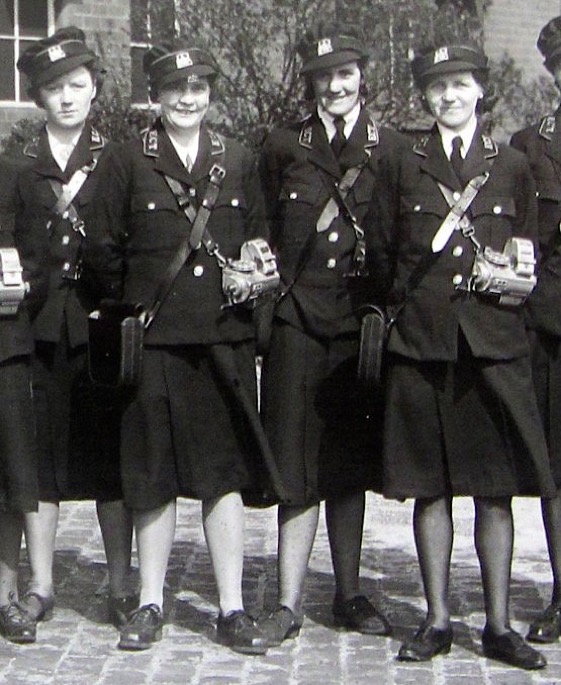
Four ECT conductresses (from a larger photograph of 12 individuals) outside Central Garage in Annandale Street — photo undated, though this is very likely a shot taken to mark the first intake of 12 ladies in May 1941. Those depicted are probably bus conductresses, though in all likelihood tram conductresses wore identical uniforms.